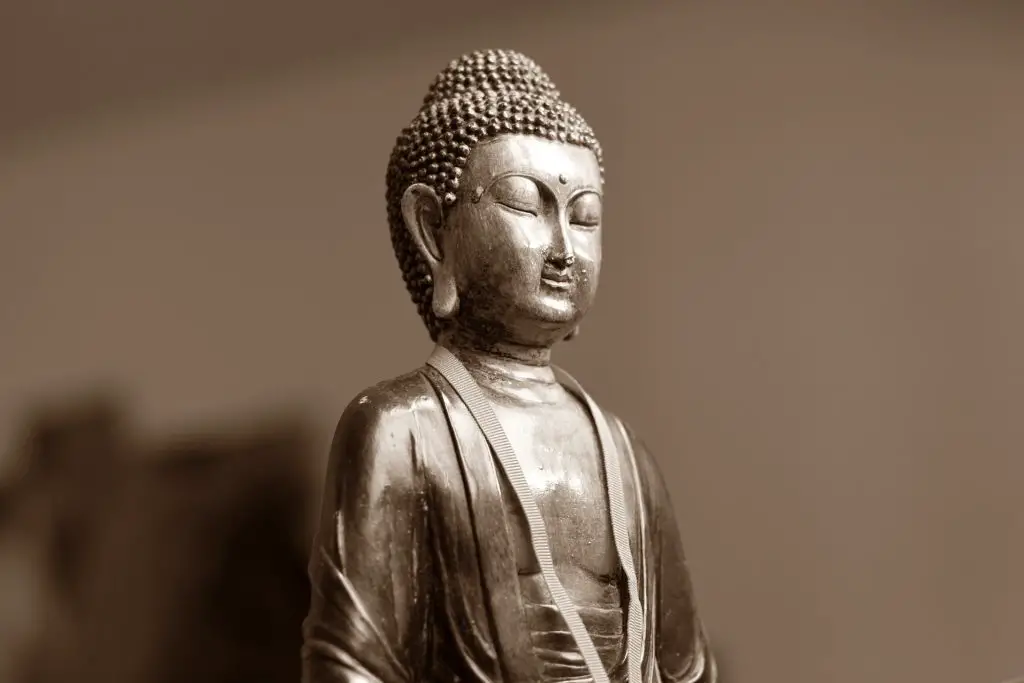Kinhin walking meditation, is a practice originating from the Buddhist tradition. This type of meditation offers a unique approach to mindfulness, as it incorporates the act of walking as the focal point, rather than solely focusing on the breath. Through kinhin, practitioners can develop a deeper understanding of the present moment, while also experiencing the benefits of gentle physical movement.

During kinhin, individuals maintain an upright posture while walking slowly along a designated path. Ensuring balance, each step taken is synchronized with the breath, promoting a sense of harmony between body and mind. The hands are held in the Shashu mudra position, which involves forming a fist with the left hand and wrapping the fingers of the right hand around it. This simple yet powerful practice allows individuals to cultivate mindfulness in their daily lives, as they engage in a meditative state while remaining active.
As an essential part of many Buddhist practices, kinhin offers both physical and mental benefits. By combining movement with meditation, practitioners can experience increased mental clarity, stress reduction, enhanced concentration, and a greater appreciation for the present moment. Furthermore, it serves as a practical approach to integrating mindfulness into everyday life, ultimately enriching the quality of one’s spiritual journey.
History and Origin
Kinhin, also known as Zen walking meditation, is a practice within several forms of Buddhism that involves movement and periods of walking between long periods of sitting meditation. It is most commonly associated with the Zen tradition but is also found in Chan Buddhism and Korean Seon.
The practice of Kinhin is believed to have originated in China, where it was called “jingxing” (经行) in the Chinese language. It was later introduced to Japan and other regions where Zen Buddhism flourished. In Japanese, Kinhin (經行) is the transliteration of the Chinese term “jinshing,” which translates to “Marching the Sutras.” Sutras are Buddhist sermons spoken by the Buddha or enlightened masters.
Throughout history, Kinhin has been practiced by Buddhist monks and laypeople as a way to maintain meditative awareness during all aspects of daily life, not just when seated in meditation. Practitioners believe that the mindfulness cultivated during Kinhin can be carried into everyday activities, helping to foster a calm and focused state of mind.
Kinhin has also been adopted by other spiritual traditions, such as yoga, through the teachings of Swami Sivananda and Swami Satyananda. This demonstrates the flexibility and adaptability of the practice, as it has been able to find relevance in various contexts and philosophies over time.
The Practice of Kinhin

Kinhin is a Zen Buddhist walking meditation practice that focuses on mindfulness, movement, and connection to one’s surroundings.
Preparation and Posture
Before starting Kinhin, find a space where you can walk comfortably without obstacles. It can be done indoors or outdoors, depending on your preference. Wear comfortable clothing and stand with your feet shoulder-width apart, maintaining an upright posture without undue tension. Distribute your weight equally between your feet and make sure your gaze is softly directed towards the ground a few steps ahead of you.
Shashu Mudra
Hold your hands in the Shashu Mudra position to maintain focus during the meditation. To form the Shashu Mudra, fold your left thumb into your left palm and wrap your fingers around it. Then, make a fist with your right hand, placing the thumb inside the fist. Finally, place your left hand over the right fist and rest the hands comfortably against your chest.
Breathing Techniques
As you walk, pay attention to your breath as it naturally flows in and out of your body. Mindful breathing is an essential part of Kinhin, as it helps to maintain focus and fosters a sense of calm. There is no prescribed pattern for the breath in Kinhin, but it is crucial to stay present and aware of each inhalation and exhalation.
The pace of walking during Kinhin can vary, but the aim is to maintain a smooth and natural rhythm. It can range from slow, mindful steps to a quicker pace that still allows for deep concentration. Choose a pace that best suits your individual practice and experience.
Kinhin can be practiced for different lengths of time, from ten minutes to an hour, depending on individual preference and experience.
Procedure and Techniques
The practice of Kinhin involves paying attention to the process of walking and sensations that arise within one’s body during the activity. There are two key sub-sections in the procedure and techniques of Kinhin Walking Meditation: Walking Pace and the use of the Inkin Bell.
Walking Pace
Kinhin walking meditation requires participants to walk at a slow and deliberate pace, focusing on each step they take. The pace of walking can be further divided into two types:
- Barefoot: Practitioners walk barefoot to better connect with the ground and feel the sensations of each step they take. This also enables one to focus thoroughly on the flow of energy within their body throughout the meditation.
- Light Shoes: For those who are unable to go barefoot, lightweight shoes can be worn. However, the essence of the practice remains the same, which is to concentrate on every step and movement.
To maintain alignment and balance during the practice, it is essential to place your hands in the Shashu mudra position. This is achieved by making a fist with one hand and lightly grasping that fist with the other hand.
Inkin Bell
An Inkin Bell, often used in Zen ceremonies, is a crucial element in Kinhin walking meditation. It serves as a signal to indicate the beginning and end of the meditation session. The bell is also used when transitioning from sitting meditation to walking meditation, marking the change of pace and intention.
When practicing Kinhin, participants walk in a clockwise direction, usually in a circular pattern, a straight line or following the path of a labyrinth. This is intended to help maintain focus and establish a rhythmic pattern during the meditation. It is important to adjust one’s pace according to the environment and personal comfort, ensuring the steps align with the breath.
As an integral part of Zen meditation practice, Kinhin walking meditation allows practitioners to seamlessly transition from sitting meditation to walking meditation, helping maintain mental clarity and focus. By paying attention to the sensations and movements of the body, participants cultivate mindfulness and a deeper connection to the present moment.
Integrating Kinhin with Sitting Meditation
Kinhin, also known as Zen walking meditation, is a practice aimed at incorporating mindfulness and meditative awareness into one’s daily life. Often performed between sessions of Zazen or sitting meditation, Kinhin helps practitioners maintain a state of awareness and equanimity during transitions between sitting and walking.
In traditional Zen practice, Kinhin is performed after a period of Zazen meditation. When the inkin bell rings at the end of a formal sitting session, practitioners rise, turn their backs to the wall and face their fellow sitters with hands in the “gassho” or palm-to-palm position. This signifies the beginning of the Kinhin period.
As the slowest paced walking meditation, Kinhin serves as a bridge between seated meditation and day-to-day activities, allowing practitioners to maintain their meditative awareness and mindfulness as they transition from one posture to another. This practice is crucial for integrating meditation into all aspects of one’s life – not just during dedicated sitting sessions.
Some benefits of integrating Kinhin with sitting meditation include the following:
- Physical relief from sitting for extended periods.
- Increased mindfulness and awareness during transitions between activities.
- Improved ability to bring meditative awareness into daily life.
While practicing Kinhin, Zen practitioners walk slowly and deliberately, maintaining mindfulness of each step and breath, synchronizing the two. This synchronization allows for a seamless flow of meditative energy and awareness between sitting and walking postures.
Overall, incorporating Kinhin walking meditation with sitting meditation enriches one’s mindfulness practice, enabling a more continuous experience of meditative awareness throughout daily life.
Benefits of Kinhin Walking Meditation

Kinhin walking meditation offers practitioners a range of physical, mental, and emotional benefits. As a form of Zen meditation, Kinhin encourages mindfulness and presence in daily activities, allowing individuals to experience the advantages of meditation even when they’re off their cushion.
One of the primary benefits of Kinhin walking meditation is stress reduction. Practicing Kinhin encourages individuals to stay attuned to their breath and present in the moment, leading to a greater sense of peace and well-being. This focused awareness helps to alleviate stress and anxiety by keeping practitioners’ minds from dwelling on intrusive thoughts or future concerns.
In addition to stress reduction, Kinhin has several physical benefits. Walking itself is an excellent form of low-impact exercise that promotes heart health, improves circulation, and burns calories. Kinhin walking meditation goes a step further by incorporating mindfulness, which can lead to better digestion and enhanced mental clarity.
Kinhin also plays an integral role in strengthening the practitioners’ vital energy or chi. When practiced between seated meditation sessions, Kinhin helps to maintain the momentum built up during the previous meditation. This continuity of practice enables individuals to make greater progress in their overall meditation journey.
To summarize, Kinhin walking meditation comes with several crucial benefits that include:
- Stress reduction
- Improved presence in the moment
- Better digestion
- Enhanced mental clarity
- Strengthening vital energy (chi)
By offering these benefits, Kinhin walking meditation provides a holistic approach to improving one’s mental, emotional, and physical well-being.
Kinhin and Energy Flow

Kinhin, the Zen walking meditation, is a powerful practice that enhances the flow of energy, or chi, throughout the body. When practicing Kinhin, the meditator focuses on their breath and movement, which can help to open up energy pathways and create a sense of balance and harmony.
One significant aspect of Kinhin is the connection to the solar plexus, an area located near the stomach that is said to be the center of a person’s chi. By focusing on the breath and maintaining proper posture during walking meditation, energy can flow more efficiently through the solar plexus, promoting overall well-being and vitality.
Attention should also be given to the forearms during Kinhin practice. The forearms are essential elements in maintaining the correct mudra, or hand position, that is used during Kinhin walking meditation. A proper mudra contributes to effectively channeling energy flow and maintaining a deep meditative state. Here is a simple mudra to use during Kinhin:
- Place your left hand on your lower chest, with your fingers pointing to the right.
- Position your right hand on top of your left hand, with your fingers pointing to the left.
- Lightly touch your thumbs together, forming a small oval shape.
When performing Kinhin, it is crucial to maintain a gentle, focused approach that allows the body and mind to connect and synchronize. In doing so, one can achieve a more profound sense of awareness, as well as enhanced energy flow throughout the body. As a result, Kinhin walking meditation can serve as a valuable tool for promoting overall health and spiritual growth.
Here is a good Kinhin Walking Meditation video:
